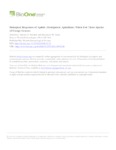Use este identificador para citar ou linkar para este item:
http://www.alice.cnptia.embrapa.br/alice/handle/doc/1058293Registro completo de metadados
| Campo DC | Valor | Idioma |
|---|---|---|
| dc.contributor.author | PARCHEN, H. A. | pt_BR |
| dc.contributor.author | AUAD, A. M. | pt_BR |
| dc.date.accessioned | 2016-12-08T11:11:11Z | pt_BR |
| dc.date.available | 2016-12-08T11:11:11Z | pt_BR |
| dc.date.created | 2016-12-08 | pt_BR |
| dc.date.issued | 2016 | pt_BR |
| dc.identifier.citation | Florida Entomologist, v. 99, n. 3, p. 456-462, 2016. | pt_BR |
| dc.identifier.uri | http://www.alice.cnptia.embrapa.br/alice/handle/doc/1058293 | pt_BR |
| dc.description | In Brazil, the forage species Brachiaria spp., Pennisetum purpureum (Schumacher), and Cynodon dactylon (L.) (Poaceae) are important components in the feed that is used to rear animals for meat and milk production. Aphids are among the insects that feed on these forage species and, at high population levels, greatly reduce the amount and quality of forage. Hence, the aim of this study was to determine the nutritional suitability of the forage species Brachiaria decumbens Stapf, C. dactylon, and P. purpureum for the aphids Sipha flava (Forbes), Rhopalosiphum maidis (Fitch), Hysteroneura setariae (Thomas), and Rhopalosiphum padi (L.) (Hemiptera: Aphididae). Nymphs, which were up to 24 h old, of the 4 aphid species were observed for a biological cycle (1 full generation) on the 3 species of forage. For each association between a species of plant and a species of aphid, 70 aphids were used to create the individual units. The number of instars and the duration and survival of each instar and nymphal stage were evaluated. Additionally, the longevity and the reproductive capacity were recorded for the adults of each aphid species, and a fertility table was prepared. These parameters of each aphid species were compared for each of the 3 species of forage supplied as food and for the identical forage. All aphid species completed their development cycles and produced offspring on all 3 species of forage. However, the duration, survival, and reproduction of the aphid species changed dependent on the nutritional suitability of the forage. For all of the aphid species, the forage P. purpureum provided the best conditions for population growth. When the aphid species were fed the identical forage, R. padi developed better and produced more offspring on all forage species. The 4 aphid species have the potential to be pests of P. purpureum, B. decumbens, and C. dactylon. | pt_BR |
| dc.language.iso | eng | eng |
| dc.rights | openAccess | eng |
| dc.subject | Nutritional suitability | pt_BR |
| dc.subject | Signal grass | pt_BR |
| dc.subject | Elephant grass | pt_BR |
| dc.subject | Bermudagrass | pt_BR |
| dc.title | Biological responses of aphids (Hemiptera: Aphididae) when fed three species of forage grasses. | pt_BR |
| dc.type | Artigo de periódico | pt_BR |
| dc.date.updated | 2017-02-22T11:11:11Z | pt_BR |
| riaa.ainfo.id | 1058293 | pt_BR |
| riaa.ainfo.lastupdate | 2017-02-22 | pt_BR |
| dc.contributor.institution | Heloise A. Parchen, UFJF; ALEXANDER MACHADO AUAD, CNPGL. | pt_BR |
| Aparece nas coleções: | Artigo em periódico indexado (CNPGL)  | |
Arquivos associados a este item:
| Arquivo | Descrição | Tamanho | Formato | |
|---|---|---|---|---|
| Cnpgl2016FloridaEntBiological.pdf | 181,37 kB | Adobe PDF |  Visualizar/Abrir |









